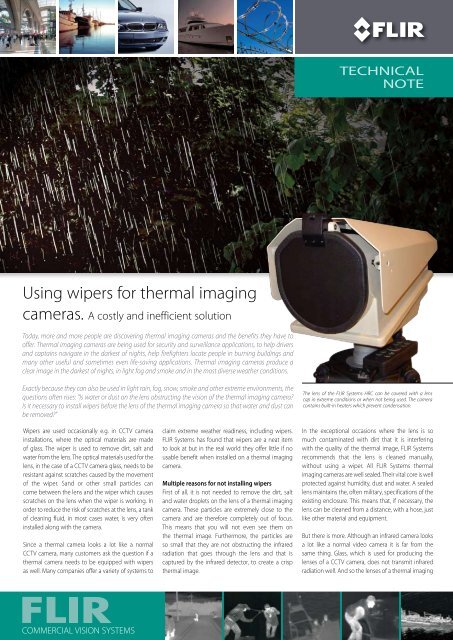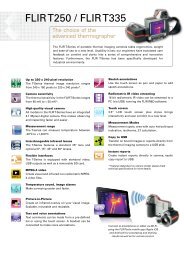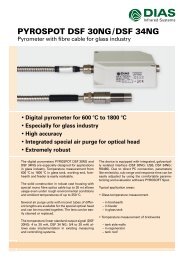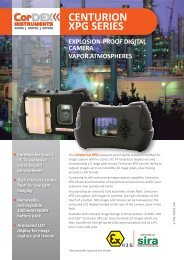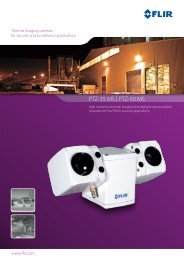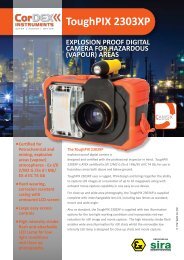Using wipers for thermal imaging
Using wipers for thermal imaging
Using wipers for thermal imaging
You also want an ePaper? Increase the reach of your titles
YUMPU automatically turns print PDFs into web optimized ePapers that Google loves.
technical<br />
note<br />
<strong>Using</strong> <strong>wipers</strong> <strong>for</strong> <strong>thermal</strong> <strong>imaging</strong><br />
cameras. A costly and inefficient solution<br />
Today, more and more people are discovering <strong>thermal</strong> <strong>imaging</strong> cameras and the benefits they have to<br />
offer. Thermal <strong>imaging</strong> cameras are being used <strong>for</strong> security and surveillance applications, to help drivers<br />
and captains navigate in the darkest of nights, help firefighters locate people in burning buildings and<br />
many other useful and sometimes even life-saving applications. Thermal <strong>imaging</strong> cameras produce a<br />
clear image in the darkest of nights, in light fog and smoke and in the most diverse weather conditions.<br />
Exactly because they can also be used in light rain, fog, snow, smoke and other extreme environments, the<br />
questions often rises: “Is water or dust on the lens obstructing the vision of the <strong>thermal</strong> <strong>imaging</strong> camera?<br />
Is it necessary to install <strong>wipers</strong> be<strong>for</strong>e the lens of the <strong>thermal</strong> <strong>imaging</strong> camera so that water and dust can<br />
be removed?”<br />
The lens of the FLIR Systems HRC can be covered with a lens<br />
cap in extreme conditions or when not being used. The camera<br />
contains built-in heaters which prevent condensation.<br />
Wipers are used occasionally e.g. in CCTV camera<br />
installations, where the optical materials are made<br />
of glass. The wiper is used to remove dirt, salt and<br />
water from the lens. The optical materials used <strong>for</strong> the<br />
lens, in the case of a CCTV camera glass, needs to be<br />
resistant against scratches caused by the movement<br />
of the wiper. Sand or other small particles can<br />
come between the lens and the wiper which causes<br />
scratches on the lens when the wiper is working. In<br />
order to reduce the risk of scratches at the lens, a tank<br />
of cleaning fluid, in most cases water, is very often<br />
installed along with the camera.<br />
Since a <strong>thermal</strong> camera looks a lot like a normal<br />
CCTV camera, many customers ask the question if a<br />
<strong>thermal</strong> camera needs to be equipped with <strong>wipers</strong><br />
as well. Many companies offer a variety of systems to<br />
claim extreme weather readiness, including <strong>wipers</strong>.<br />
FLIR Systems has found that <strong>wipers</strong> are a neat item<br />
to look at but in the real world they offer little if no<br />
usable benefit when installed on a <strong>thermal</strong> <strong>imaging</strong><br />
camera.<br />
Multiple reasons <strong>for</strong> not installing <strong>wipers</strong><br />
First of all, it is not needed to remove the dirt, salt<br />
and water droplets on the lens of a <strong>thermal</strong> <strong>imaging</strong><br />
camera. These particles are extremely close to the<br />
camera and are there<strong>for</strong>e completely out of focus.<br />
This means that you will not even see them on<br />
the <strong>thermal</strong> image. Furthermore, the particles are<br />
so small that they are not obstructing the infrared<br />
radiation that goes through the lens and that is<br />
captured by the infrared detector, to create a crisp<br />
<strong>thermal</strong> image.<br />
In the exceptional occasions where the lens is so<br />
much contaminated with dirt that it is interfering<br />
with the quality of the <strong>thermal</strong> image, FLIR Systems<br />
recommends that the lens is cleaned manually,<br />
without using a wiper. All FLIR Systems <strong>thermal</strong><br />
<strong>imaging</strong> cameras are well sealed. Their vital core is well<br />
protected against humidity, dust and water. A sealed<br />
lens maintains the, often military, specifications of the<br />
existing enclosure. This means that, if necessary, the<br />
lens can be cleaned from a distance, with a hose, just<br />
like other material and equipment.<br />
But there is more. Although an infrared camera looks<br />
a lot like a normal video camera it is far from the<br />
same thing. Glass, which is used <strong>for</strong> producing the<br />
lenses of a CCTV camera, does not transmit infrared<br />
radiation well. And so the lenses of a <strong>thermal</strong> <strong>imaging</strong><br />
COMMERCIAL VISION SYSTEMS
technical<br />
n o t e<br />
camera are made of germanium. This metal is a good<br />
transmitter of infrared radiation. It is however a very<br />
expensive metal so the lens needs to be protected as<br />
much as possible against scratches. If the germanium<br />
lens becomes scratched and pitched, e.g. by the<br />
small particles between a wiper and the lens, there<br />
is a steady decline in the <strong>thermal</strong> image quality. In<br />
situations where the smallest of details need to be<br />
detected, this is unacceptable.<br />
Most FLIR Systems infrared cameras have hard carbon<br />
coating. Although this coating is putting a protective<br />
layer over the lens and protecting it against scratches<br />
and pits in practically all weather conditions, it can be<br />
scratched and damaged by the use of a wiper.<br />
Another reason <strong>for</strong> installing <strong>wipers</strong> might be that the<br />
cameras are often per<strong>for</strong>ming in humid conditions<br />
and that condensation can occur on the lens. FLIR<br />
Systems <strong>thermal</strong> <strong>imaging</strong> cameras that need to<br />
per<strong>for</strong>m in these conditions are practically always<br />
equipped with built-in heaters that are preventing<br />
condensation on the lens. So again, there is no need<br />
to install <strong>wipers</strong>.<br />
Wipers: increasing cost and downtime<br />
When using a <strong>thermal</strong> <strong>imaging</strong> camera, installing<br />
<strong>wipers</strong> is definitely not the best option. Not only<br />
because they are likely to damage the expensive<br />
germanium lens of the camera, but installing <strong>wipers</strong><br />
is also a costly item in terms of initial system design<br />
and maintenance.<br />
Many of FLIR Systems’ Thermal <strong>imaging</strong> cameras<br />
use the front lens element as the seal against the<br />
environment and not an extra, flat IR window. This<br />
means that a potential wiper must follow the lens<br />
curvature to clean it properly.<br />
Customers that absolutely want to install a wiper,<br />
do not only have to face the price of the initial<br />
installation. Definitely in security and surveillance<br />
applications, <strong>thermal</strong> <strong>imaging</strong> cameras are often<br />
installed in a high position so that they can overlook<br />
an entire area. In a fixed pole or building mount<br />
scenario this requires man power to climb the pole<br />
and either replace the wiper at the top of the pole<br />
or un-mount the entire camera assembly and bring<br />
it to the ground <strong>for</strong> repair. In both cases this means<br />
an additional maintenance schedule. Not only will<br />
this increase the exploitation cost, but even more<br />
important, the camera will be out of use <strong>for</strong> a period<br />
of time which is often unacceptable.<br />
A wiper system <strong>for</strong> a <strong>thermal</strong> <strong>imaging</strong> camera must<br />
also include a water spray (or similar) in order to try<br />
avoiding lens damages. This is rather tricky with a slip<br />
ring based, continuous rotating Pan/Tilt Head (PTH).<br />
The cleaning fluid needs a reservoir installed on top<br />
of the Pan/Tilt (along with the cameras) and requires<br />
additional, regularly refill service.<br />
Experience has learned that if <strong>wipers</strong> and a water<br />
spray installation are installed there is always the risk<br />
of operators playing with it. This leads to additional<br />
refill services and maintenance which is again<br />
increasing the operational cost of the <strong>thermal</strong><br />
<strong>imaging</strong> system. And if the lens is really dirty, spraying<br />
water on it and cleaning it from a distance with a<br />
wiper, will create a layer of mud which will obstruct<br />
the <strong>imaging</strong> capabilities of the camera.<br />
Better options to protect the lens of a <strong>thermal</strong><br />
<strong>imaging</strong> camera in extreme conditions.<br />
All the above arguments quickly lead to the conclusion<br />
that installing <strong>wipers</strong> on a <strong>thermal</strong> <strong>imaging</strong> camera<br />
is not a good, and definitely not a cost effective,<br />
solution.<br />
It has to be admitted however that there are extreme<br />
conditions in which even a <strong>thermal</strong> <strong>imaging</strong> camera<br />
can not produce a clear image and where its<br />
germanium lens needs to be protected against the<br />
environment in order to protect it against damage.<br />
FLIR Systems has installed many <strong>thermal</strong> <strong>imaging</strong><br />
cameras in extreme climate conditions. Numerous<br />
FLIR Systems cameras are being used today in the<br />
dessert, in arctic climates, along coastal borders, ...<br />
So how are the lenses protected against scratches<br />
in sand storms and other extreme conditions? FLIR<br />
Thermal imagers that are installed in these conditions<br />
are equipped with a so called “parking position”.<br />
This means that if they are not being used, <strong>for</strong><br />
whatever kind of reason, they can be remotely turned<br />
and positioned into a pose that they are protected<br />
against the environment. Another possibility is that a<br />
lens cap can be remotely positioned be<strong>for</strong>e the lens<br />
to protect it.<br />
In both cases, the expensive germanium lens is<br />
well protected against scratched and other possible<br />
damage. There is no risk at all, that by using a wiper,<br />
which is probably not effective at all, the lens is<br />
getting damaged.<br />
And FLIR Systems <strong>thermal</strong> <strong>imaging</strong> cameras that do<br />
have a dirty lens can be quickly, from a distance,<br />
cleaned with a hose, a fast and cost effective solution,<br />
so that they are again producing the crisp, clear,<br />
detailed <strong>thermal</strong> images <strong>for</strong> which FLIR Systems is<br />
renowned in the market.<br />
Both the<br />
FLIR Systems<br />
PTZ-35x140 MS and<br />
the Voyager have<br />
a parking position.<br />
In this position, the<br />
expensive germanium<br />
lens is protected<br />
against scratches.<br />
The protective lens cap of the HRC can remotely be positioned<br />
be<strong>for</strong>e the lens to protect it.<br />
For more in<strong>for</strong>mation about <strong>thermal</strong> <strong>imaging</strong><br />
cameras or about this application,<br />
please contact:<br />
FLIR Commercial Vision Systems B.V.<br />
Charles Petitweg 21<br />
4847 NW Teteringen - Breda - Netherlands<br />
Phone : +31 (0) 765 79 41 94<br />
Fax : +31 (0) 765 79 41 99<br />
e-mail : flir@flir.com<br />
www.flir.com<br />
TN_0308_0004_EN


